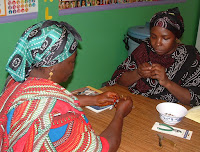This is a blog about a dynamic group of refugee women. If you're not sure what, exactly, a refugee is, you can find a good definition here. Some of the populations that resettle in Denver don't have as large a cultural gap to negotiate as others (say, Russians compared to Sudanese). The group that has had it the hardest in the past 20 years, though, has been the Somali Bantu.
The Bantu were an ethnic minority in Somalia and when the central government collapsed there about 15 years ago, the Bantus' situation went from bad to incomprehensibly bad. They lived in refugee camps for well over a decade before the UN and the governments of several countries concluded that repatriation was never going to be an option, leading to the Bantus' resettlement shortly thereafter.
Prior to resettlement, most Bantu had never lived in a home with electricity, plumbing, or even the smallest modern technology at all. As a population, the Bantu had never been literate, nor was there a written form of their language until fairly recently. Many of the Bantu who resettled here were widows with children. The learning curve was very steep, indeed. Language. Life skills. Literacy. Cultural expectations. Health concerns. It was overwhelming.
About 2 1/2 years ago, a group of volunteers started a Saturday morning language and literacy learning group for women only. We found that the women learned best in a casual, group setting and with no men in the class. The class has been an amazing revelation about potential, determination, human nature, and patience all around.
A couple of months ago, the Bantu women expressed an interest in learning crafts--something they had had access to before the war. One of the volunteers thought bead stringing would be a good way to work on manual dexterity, focus, following instructions, and nurturing creativity (and it was a lot cheaper than finding 20 sewing machines).
I have only been overseeing the Saturday Bantu Ladies' Project at this point--I haven't been teaching this group. I became aware of the beading because of one of the other parts of my job, which is matching volunteer tutors with refugee women who can't attend English classes at school (refugee women from anywhere. Lately, that's lots of Burmese). In my work making home visits to refugee families, I noticed that lots of Somali kids and their moms were wearing simple, beaded bracelets and necklaces. I mean, like, everybody. I found out very soon that the Saturday ladies were totally enamored with making necklaces and bracelets using supplies that the volunteers had scraped together on their own or bought with their own money. Above and beyond the call of duty, for sure.
Now that the students are gaining confidence with their skills in making simple yet pretty beaded jewelry, they are planning to sell their work at the farmer's market where the Bantu community sells produce (much of it grown by themselves in urban gardens). This is a huge step for these women to connect their class to a tangible skill to a way to make a little pocket money. If the group can commit, a micro-loan may be in the future. That's a no-interest loan of a small amount of money to start a little business that fosters self-sufficiency skills.
The whole over-arching goal of the refugee resettlement programs is always self-sufficiency, and that can be a tall order for a group like the Bantu women. Even the married women are cash-poor. Their husbands usually don't give them pocket money, let alone an allowance. The money from the beading project will be 100% earned and kept by the women. Empowerment. Yea!!
You can see a fun 3-minute video clip of our group on YouTube by clicking here. If you can't understand the words to the song, it's "Thank-a-you, thank-a-you, thank-a-you, thank-a-you (repeat in May-May lanugage)." Anyway, these are the women in the Saturday English/Literacy and now Beading group! BTW--singing and dancing like this tends to break out spontaneously in class. It's very encouraging when you're a teacher :-)
I'll be paying regular visits to the class now to show a few jewelry making techniques. Me--teaching jewelry making--who knew? --SM
 What can I say? Gorgeous weather, decent traffic, lots of interest in the project. On the other hand, our table wasn't there, we were missing part of our display...we improvised and it was fine. What really mattered was this: We sold jewelry! All things considered, we did really well this weekend.
What can I say? Gorgeous weather, decent traffic, lots of interest in the project. On the other hand, our table wasn't there, we were missing part of our display...we improvised and it was fine. What really mattered was this: We sold jewelry! All things considered, we did really well this weekend.















